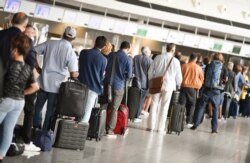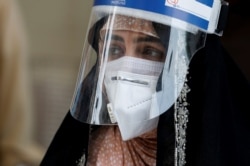Authorities in Beijing have imposed quarantine measures on at least 21 neighborhoods to prevent the further spread of the novel coronavirus that has now sickened 106 people in the Chinese capital.
The total number of cases rose Monday after officials confirmed 27 new infections. The Beijing outbreak, which was first reported last Thursday, have been linked to the Xinfadi seafood supermarket in the city’s southwestern district.
About 90,000 residents living in the sealed-off neighborhoods have been ordered to quarantine at home and undergo regular testing. Beijing authorities have also banned residents of high-risk neighborhoods from leaving the city, and have imposed a similar ban on taxis and car-hailing services.
Despite Beijing’s efforts, a handful of COVID-19 cases have been reported outside the capital. At least one person has tested positive for the virus in Sichuan province after flying from Beijing, while neighboring Hebei province have reported four new cases, three of them believed to be connected to the Beijing outbreak.
Several cities are requiring travelers from Beijing to undergo a strict isolation period upon arrival to prevent a recurrence of the outbreak that began in the central city of Wuhan late last year, sparking a pandemic that has now sickened over 8 million people, including 436,901 deaths.
Meanwhile, New Zealand has reported its first new confirmed cases of COVID-19 just days after declaring itself free of the virus. Authorities say two women who flew in from London to visit a dying relative tested positive, but only after being allowed to leave quarantine and drive across the country from Auckland to Wellington.
The World Health Organization (WHO) says there is no place it considers to be a “zero risk” environment for the coronavirus.
The head of the WHO emergencies program, Dr. Michael Ryan, was answering a reporter’s question Monday in Geneva about the safety of air travel as many European countries reopen their borders to tourists from other EU nations.
WHO Director General Dr. Tedros Adhanom Ghebreyesus warned of a possible resurgence of COVID-19 in countries where the pandemic has appeared to have subsided.
Tedros said more than 100,000 confirmed cases of coronavirus have been reported worldwide each day over the past two weeks and countries that have curbed transmissions "must stay alert to the possibility of resurgence." Most of the new cases are in the Americas and South Asia, he said.
Among those South Asian nations is Pakistan where experts say the number of coronavirus cases could double by the end of the month if people continue to ignore social distancing and other precautions.
Pakistan had 144,478 cases and 2,729 deaths, according to Johns Hopkins University tracking as of Monday, and officials there warn there could be as many as 1.2 million cases by July. Pakistan lifted its lockdown on May 9, citing economic stress, and has since seen infection rates rise from 1-in-10 tests to more than 1-in-5.
Meanwhile, millions of Europeans are again filling restaurants and putting their feet in sandy beaches as border restrictions have been lifted across much of the continent.
Americans and Asians are still restricted from coming to the European Union (EU) for at least another month, but many European tourists are allowed to once again visit their neighbors even while they are still urged to show caution.
“We have got the pandemic under control, [but] the reopening of our frontiers is a critical moment,” said Spanish Prime Minister Pedro Sánchez. “The threat is still real. The virus is still out there.”
Travelers arriving in Greece are no longer required to be tested for COVID-19.
But visitors to Britain must enter a 14-day quarantine, prompting several countries to keep their borders closed to Britons for the meantime.
In the United States, a new report by the Centers for Disease Control and Prevention says the COVID-19 death rates for people with chronic illness is 12 times higher than others who get infected.
The top illnesses that pose a greater risk of death are heart disease, diabetes, and lung disease.
A new survey by the University of Chicago finds that 11% of African Americans had a close friend or family member who died from the coronavirus compared to 4% of whites.
Health experts say while preexisting conditions and limited access to quality health care play a part in the gap, other reasons loom.
And new projections from a model created by the University of Washington’s Institute for Health Metrics and Evaluation says the coronavirus death toll in the United States could top 200,000 by October.















